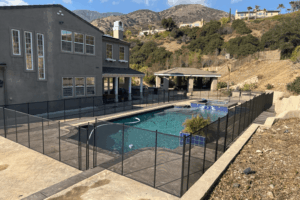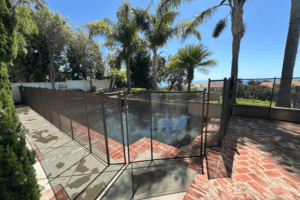
10 Questions to Ask Before Buying a Pool Safety Fence
Don’t buy a pool safety fence without asking these essential questions. This buyer’s guide helps you evaluate height, compliance, materials, installation, and more.
Home > Pool Safety Inspection Checklist to Help You Prepare

Make sure your safer swimming pool is ready for inspection with our pool safety inspection checklist. Whether you’re installing a new pool on your property or buying a home with an existing pool, you’ll need a comprehensive inspection. One of the primary concerns the inspector will be looking at is your swimming pool’s safety features and equipment. It takes more than just following a few pool safety tips to keep swimmers protected, so let’s take a look at what the inspector will be checking in and around your swimming pool.

Most new pool or new home inspections will be looking at more than just your safety equipment. They’ll check to ensure the pool’s structure is in good shape, the condition of your deck surrounding the pool, and verify any features or amenities you’ve installed to get more from your swimming pool area are not introducing a hazard to the pool area. These comprehensive pool inspections can vary greatly based on your pool’s unique layout.
With so many different types of pools and spas, along with manufacturers of pumps, filtration systems, heaters, and lights, there’s no way we could address them all beyond advising you to refer to your owners’ manuals or contact a pool company for a pre-inspection check-up. We can, however, help you make sure you’re ready to ace the safety portion of the inspection with an easy-to-follow pool safety inspection checklist.
While that gives you a quick overview of what your inspector will be looking for, let’s take a full look at what each of our pool safety inspection checklist items means. We’ll talk about what the inspector will be checking for and give you a few pool safety tips to make sure your pool passes with flying colors.
The Virginia Graeme Baker Pool and Spa Safety Act sets the standard for anti-entrapment and entanglement devices in public pools and spas, but more and more jurisdictions are codifying these safety improvements into their pool safety regulations. All pool drains should have anti-entrapment drain covers that prevent the suction from pulling a child or weak swimmer against the intake and trapping them underwater. For pools that can’t be retrofitted with these drain covers, a safety cut-off on the main drain must release the pressure to free a trapped swimmer.

Your swimming pool fence should not have any damage that could put a swimmer at risk or compromise its effectiveness. It should deter climbing, be secured with a self-closing, self-latching gate, and have no gaps large enough to pass a four-inch sphere through under the pool fence or around the gate or any pole. Your jurisdiction will also set a minimum height requirement–often 48”-60” measured from the ground outside the enclosure to the top of the lowest point of the fence. You’ll also want to make sure no landscaping or yard equipment is nearby that can be used to help a good climber gain unsupervised access.
Like your pool safety fence, your safety nets or covers serve as a barrier to prevent accidental drownings by limiting access to your pool. Make sure the woven knots or mesh material that comprise your surface barrier are in good repair, with no fraying, tears, or rips. Anchor straps should be tight and unfrayed. When installed on their anchor points, the cover or net should stretch taut to ensure an at-risk person is held up and out of the water.
Rescue hooks, long poles, flotation devices, and first aid kits should have their locations clearly marked to ensure they can be found by anyone poolside in the event of an emergency. While many jurisdictions do not require specific rescue equipment, ensuring you have the tools you need should an emergency happen is one of the most important pool safety tips we can give to any owner.
Swimming pool alarms come in a variety of styles, from pool gate alarms to immersion detectors and surface monitors. Your alarms should give an audible or visible indicator when triggered, and smart alarms should be connected to your network and paired to the devices they’ll alert when they’re triggered. Be sure to check all batteries regularly to prevent a dead battery from creating a dangerous situation.
Electricity and water don’t mix. Make sure all electrical equipment in your pool area, such as lights, sound systems, or features, has been installed by an electrician experienced in working with swimming pools. All outlets should be GCFI-type outlets placed far enough away from the pool to avoid splashing, and extension cords have no place in the pool area. Any metal pool furniture or fixtures should be bonded to route electrical currents safely to ground.
While getting ready for your swimming pool inspection, it’s important to know when to get professional help. While some of the items on our swimming pool safety inspection checklist can be addressed by the homeowner for some repairs, many will require someone who has the training, experience, and tools to ensure your pool is safe and ready to pass.
For pool safety barriers, the professional in your corner is your local independent All-Safe Pool Installer. They live and work in your community, so they’re familiar with local requirements and ready to help you create a safer swimming pool area. Schedule an appointment with them to set up an appointment for pool safety barrier repair, installation, or to go over your pool safety inspection checklist. Get help with your ASTM-compliant pool safety barriers from All-Safe Pool.

Don’t buy a pool safety fence without asking these essential questions. This buyer’s guide helps you evaluate height, compliance, materials, installation, and more.

Understand how local pool fence codes work and what to check before installation. This beginner’s guide simplifies requirements so your safety barrier complies and protects effectively.

Learn the truth behind common pool safety myths and make better decisions to protect your family with fact‑based guidance on fences, barriers, and maintenance.
Enter your zip code to locate an independent installer in your area
Enter your zip code to locate an independent installer in your area

Due to the many variations in monitors, phones, and browsers, color samples and product examples may appear different on different screens. Computers and mobile devices are not all calibrated equally and color reproduction on the Internet is not precise. The same is true for printed items such as brochures and other sales literature.
In addition, the colors of our products photograph differently under different lighting conditions. For example, photos taken in full sunlight will vary from photos taken on a cloudy or overcast day. Similarly, shadows from nearby objects can affect the color and transparency of our products. If a precise color or specific shade is important, please inspect the actual color of your product prior to installation.
Many of our products’ materials are not available through typical stores and vendors and therefore must be custom manufactured specifically for our use. In order to control costs and provide you with the best value possible, our raw materials are produced in large batches and can often take several months to receive. The colors of our materials can, and often do, vary slightly from batch to batch. Although we make every effort to minimize color variations, we cannot be responsible for these differences when they occur. If a precise color or specific shade is important, please inspect the actual color of your product prior to installation.
For example, we use the name “putty” to describe some of our products. Your idea of the color “putty” may be different than someone else’s idea of “putty”. In addition, products may have the same color name but may not be the exact same color. For example, we have different shades of “black”. Please do not order using color names as your only guide. If a precise color or specific shade is important, please inspect the actual color of your product prior to installation.
If it is important that your product be an exact color or shade, it is highly recommended that you inspect the actual product prior to its installation and address any concerns with your local independent installer. Most independent installers do not offer refunds or accept returns due to color variations.